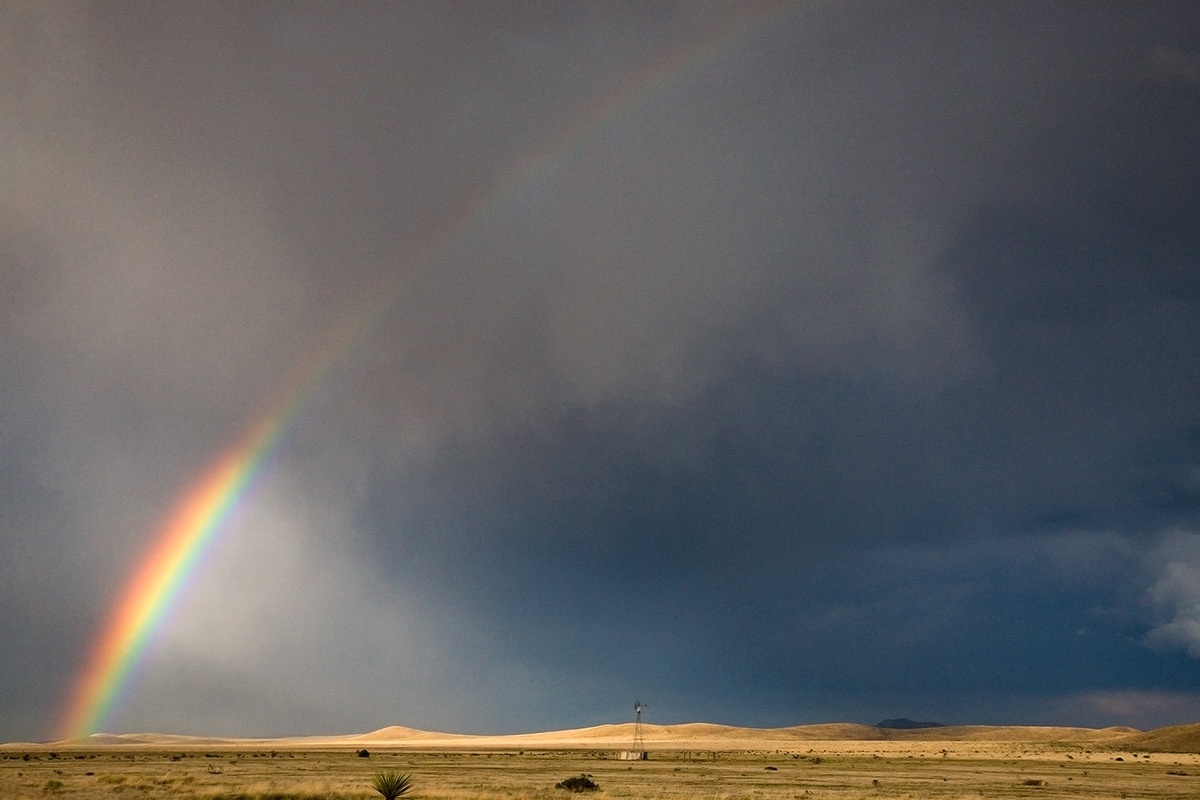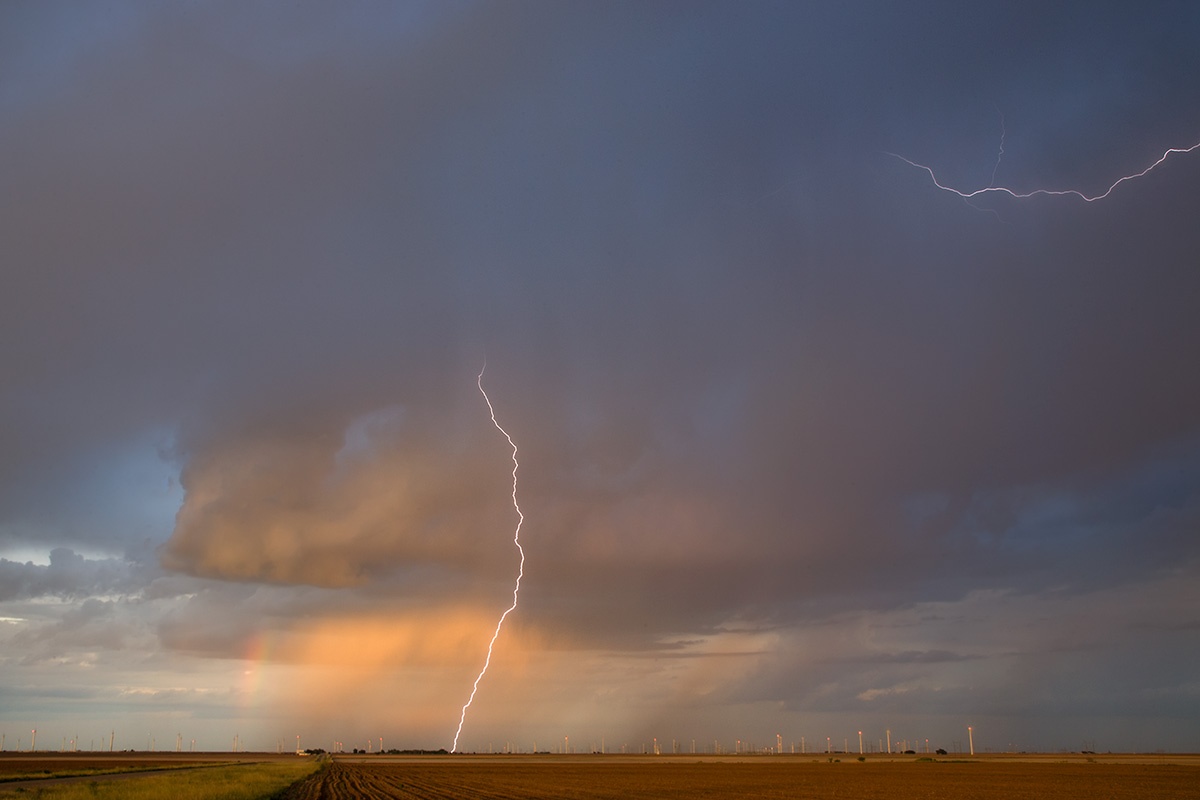Texas skies are their most enigmatic when they appear to be most calamitous, a pinnacle moment in a journey that begins with cotton-white puffing against a bright blue horizon and peaks with a dramatic exhibition of lightning, rain and the full voice of thunder.
When observed from a safe place, a storm-loaded sky captures our attention with its power and beauty, an inscrutable behemoth unlikely to release its hold on us even after it passes. Then, we love the calm as much as the commotion that preceded it, the trailing rainbows that alight as quickly as they disappear, and the dewy twilight that follows.
In fact, we’re enamored with weather of all kinds. We love the mists of spring, the dense fog of mornings and the regional Texas snowfalls of deep, midwinter nights. We anticipate with joy and melancholy the arrival of autumn’s first frost, the frigid Texas blue northers and hazy summer dusks.
Why the obsession? Perhaps because weather connects us to the natural world with a mere glance out the window. Pondering its variables offers the pleasure of puzzling out the catalysts of our sky’s constantly changing conditions. Despite advances in meteorology, weather remains unpredictable. Consequently, just about everyone feels qualified to speculate about it, and Texas, with its robust skies and plenty of action, offers a lot to speculate about.
Among the lists of weather extremes for the nation compiled by the National Climatic Data Center, Texas occupies three dominant spots for frequency and severity of hail, one for highest number of tornadoes, one for the all-time hottest and driest, two positions for the top 10 windiest, and three for the most humid.
Professional weather services sort out most of the details, but many of us enjoy documenting the skies from our own backyards under the Citizen Weather Observer Program. Texans across the state collect weather data and upload it daily, providing pinpoint details for the country’s official sky watchdog, the National Weather Service, part of the National Oceanic and Atmospheric Administration. The NWS maintains a network of official weather data sites across the country, and many have been gathering records for at least a century, including dozens of the Cooperative Observer Program sites throughout Texas. By 1910, Texas sky watchers in rural outposts such as Alpine, Beeville and Temple began archiving weather conditions by hand. Early records, a weather legacy written in fountain pen ink, include such oddities as number of days with “windstorms” and “fogs” recorded in pages of ones and zeros, foreshadowing the digital age.
Texans are not alone in their zeal for observing the skies. It’s a national enthusiasm. Chris Davis, senior scientist at the National Center for Atmospheric Research, says we have a good reason for our passion.
“The severity of weather in America is generally much greater than in other parts of the world, when one considers extremes of heat and cold, snow, rain and wind,” explains Davis. “Many locations [in the U.S.] experience a range of more than 100 degrees Fahrenheit between their high and low temperatures for a given year. Such a range occurs in very few populated areas elsewhere in the world.”
Tornadoes occur with frequency in the U.S. but are relatively unusual in many other countries and, unlike Europe, hurricanes routinely threaten the U.S. coastline. None of these weather patterns, however, has proved to be reliably predictable.
The oldest official weather prognosticator in the country, “The Old Farmer’s Almanac,” has been around since 1792. Considered America’s most enduring reference manual for weather forecasts, planting charts, astronomy and tide tables, “The Old Farmer’s Almanac” continues to use the same secret forecasting formula today that its publisher and founder, Robert B. Thomas, developed more than 200 years ago. Thomas based his forecasting technique on weather, solar and astronomical patterns, following a formula that appears to be more successful than many. Today, the formula is re-ported to be kept in a locked black box in the publication’s offices and removed only once a year for the annual forecast.
Texans who wish to do a little forecasting on their own should engage in an age-old pastime—cloud watching. The simple observation of clouds and their shapes serves as a good gauge for judging upcoming weather conditions, a technique in use by humans for centuries. Puffy, rolling giants (cumulonimbus) suggest possible thunderstorms; low, overcast cloud cover (nimbostratus) usually contains drizzle; white, wispy clouds (cirrus) often predict fair weather or a change; and high, thin, sheet-like clouds (cirrostratus) often indicate wetter weather on the way.
If you’re venturing out to observe changing weather, you should keep a few rules in mind. Always put safety first. Seek shelter at the first sign of a thunderstorm. When driving, don’t try to negotiate a flooded low-water crossing. Wait it out. Your tires, like balloons, are filled with air. They float. If the skies are looking green, you might want to pull under the nearest overpass, as hail may be on its way. If you have to pull onto the road shoulder, don’t forget to switch on your hazard lights, and never leave your car when lightning is striking. Stay inside. A lightning strike can be deadly, even when it lands a short distance away.
Weather appears to provide a common denominator that links humanity across the centuries. As weather unites us, it also is the great equalizer, providing daily challenges for coping with conditions that appear completely out of our control.
A change in the climate seems to be on almost everyone’s mind today. But what does our weather data tell us about the climate, and what does it portend for future Texans and our natural environment? Many of our climate scientists are making headway with the answers, including John W. Nielsen-Gammon, the Texas state climatologist.
“The climate in Texas has varied considerably during the past century,” Nielsen-Gammon says. “By far the most significant climate event was the drought of the early to mid-1950s, when Texas experienced some of its driest and hottest years.” Although the drought broke with a long cooling period, the rise in temperatures thereafter has been more rapid, says Nielsen-Gammon.
“Just based on temperatures alone,” he explains, “one could not conclude that the temperature in Texas will continue rising. However, there is plenty of other evidence that temperatures should continue to rise, in general. And Texas temperatures are now at their historical highs compared to the past century, so any continued warming will take temperatures beyond the realm of past experience in Texas.”
So what does the changing climate hold for Texans? Will it be hotter? Drier? Opinions abound. Every Texan has one. But one factor about the weather will remain the same—our enthusiasm for keeping an eye on the sky.
——————–
Photographer, author and artist E. Dan Klepper works in Marathon.










